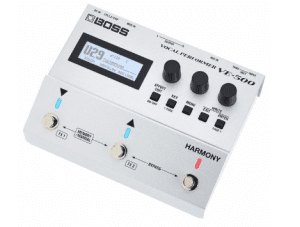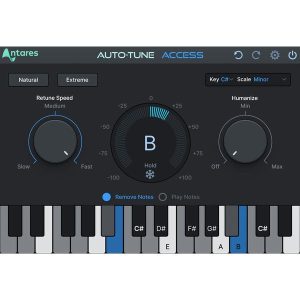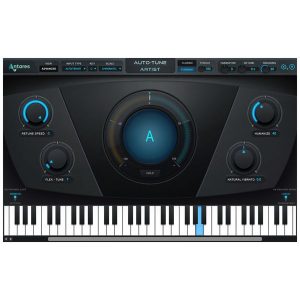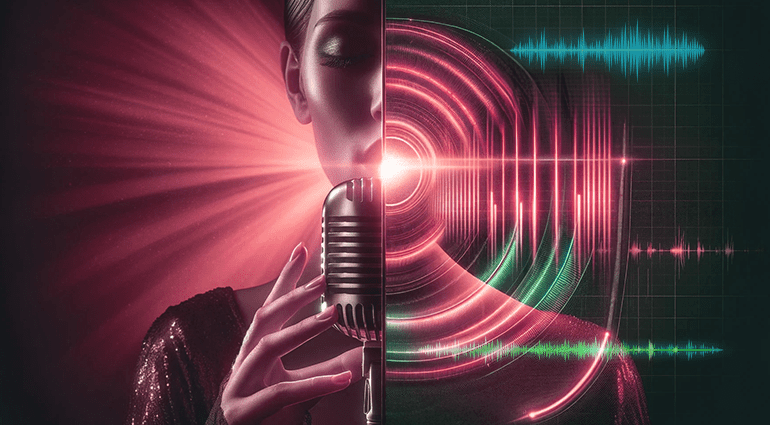Auto-Tune is one of the most frequently used effects in modern music. There’s hardly any current pop production that doesn’t feature it. But what is Auto-Tune anyway, how does it work, and is the prevalence of Auto-Tune in modern music a bad thing? Let’s take a closer look!
What is Auto-Tune?
Simply put, Auto-Tune is a pitch correction algorithm that shifts an incoming audio signal to the desired pitch in real time. Hence the name: automatic tuning. Curiously, the technology was originally developed by Andy Hildebrand for an American oil company to facilitate seismic data analysis. In the beginning, it didn’t have anything to do with music at all! But that changed when Antares introduced the ATR1 rackmount effect unit in 1996, thereby making Auto-Tune available to musicians. While the ATR1 has long been discontinued, it can still be found in many studio and live racks to this day.
You are currently viewing a placeholder content from YouTube. To access the actual content, click the button below. Please note that doing so will share data with third-party providers.
Today, Auto-Tune is mostly used as a plug-in on the computer. In addition to various versions by Antares, other manufacturers offer plug-ins with similar capabilities, such as Waves Tune or Celemony Melodyne. Some can even process polyphonic audio signals. Many DAWs come with built-in pitch correction effects out of the box, and hardware effect units such as the Boss Vocal Performer or the TC Helicon VoiceLive series also offer comparable features.

What exactly does Auto-Tune do?
Auto-Tune and related effects analyse the pitch of an incoming signal and – if required – shift it to another frequency previously specified by the user. You can either specify individual pitches or entire scales and then adjust the speed and rigidity of the pitch shifting effect. Some plug-ins also offer the option to manually draw in a pitch correction curve over a previously analysed signal, which is more precise and flexible, but also means a lot more work.
You are currently viewing a placeholder content from YouTube. To access the actual content, click the button below. Please note that doing so will share data with third-party providers.
How did Auto-Tune become famous?
It might not be obvious from today’s perspective, but Auto-Tune was actually intended to be an inaudible effect when it was first conceived. But if you overdo it and adjust the parameters so that Auto-Tune reacts very quickly and firmly holds pitches that may not even be present in the original signal, you will hear the characteristic jumps. The producers of Cher’s hit “Believe” took advantage of this in 1998. The song was the first to re-tune the vocals in such a brutally audible way, which is why Auto-Tune is still sometimes referred to as the “Cher effect”.
You are currently viewing a placeholder content from YouTube. To access the actual content, click the button below. Please note that doing so will share data with third-party providers.
Is Auto-Tune a bad thing?
After Cher’s huge success with “Believe” – number 1 in the USA, UK, Germany, and other countries, plus numerous gold and platinum awards – other producers quickly jumped on the bandwagon. The following years saw a huge wave of songs with drastically manipulated vocals. Daft Punk, Chris Brown, Rihanna, Britney Spears, Black Eyed Peas, Kesha, and many more all released songs that featured Auto-Tune as a very audible effect. It’s still often used as a stylistic element today, even though you might think that you’ve had about enough of it.
You are currently viewing a placeholder content from YouTube. To access the actual content, click the button below. Please note that doing so will share data with third-party providers.
But even if you can’t actually hear Auto-Tune, that doesn’t mean that it wasn’t used – after all, it was originally designed to be inaudible. Nearly every modern production features Auto-Tune in one way or another. Even the best singers use it to polish their voices to absolute (pop) perfection. And not just in pop – Auto-Tune has long been a staple in the toolboxes of rock singers and producers, as well. Unless you have a pair of highly trained ears and the opportunity to listen to a solo vocal without the backing tracks, you probably won’t even notice that something has been manipulated.
Which takes us to the core of the issue: Doesn’t Auto-Tune suck the life out of a voice? Is perfection down to the smallest detail really what we want? Isn’t it precisely the little nuances and inaccuracies that make all the difference in a great voice? Unfortunately, it looks like many producers don’t think twice and always play it safe.
You are currently viewing a placeholder content from YouTube. To access the actual content, click the button below. Please note that doing so will share data with third-party providers.
Software & Plugins for Auto-Tune: This is how you get the effect!
Would you like to use Auto-Tune as an effect yourself? Simply use specialized software like Antares Auto-Tune or similar plugins as an insert effect on the vocal track. Applied gently, it corrects the voice; for the distinctive Auto-Tune sound, adjust the processing time to its minimum value and permit no deviations from the targeted pitch. Below you will find a few product examples. If you have any questions, please contact us by email or just call.
🛒 Shopping List 🛍️



👉 Discover Antares Auto-Tune Software here 👈
👉 Discover Celemony Melodyne Software here 👈
Do you want to know more about vocal effects? In this blog article we will introduce you to four more, just click here .
If you have any questions about products , our colleagues from the specialist departments will advise you . You can find the contact details using this link .
Auto-Tune doesn’t have to be evil!
That said, Auto-Tune does have many advantages. For example, it is not limited to vocals, but can handle a wide variety of audio signals. Acoustic instruments can be out of tune for many reasons. Maybe you’ve got a great-sounding acoustic guitar, but the intonation is ever so slightly off on recording day, and you don’t notice it until mixdown. By applying Auto-Tune carefully, you can save the recording while preserving the character of the instrument.
You are currently viewing a placeholder content from Giphy. To access the actual content, click the button below. Please note that doing so will share data with third-party providers.
The same is true for vocals. Maybe you’ve captured a golden take that perfectly fits the mood of the song, but the pitch is just a tiny bit off here and there. If you use Auto-Tune sparingly and adjust it so that it acts rather gently and slowly, chances are high that you’ll be able to recover the recording.
Auto-Tune – what remains?
Whether it’s used as a clearly audible effect or for the smooth corrections it was intended for, Auto-Tune has become an integral part of today’s music. It is an industry standard that’s used in almost every style of music. So is Auto-Tune bad or good in modern music? Ultimately, that’s something that everyone must decide for themselves.
Feedback: Auto-Tune
What do you think about Auto-Tune? Good or bad? Do you use pitch correction effects yourself or do you prefer to keep your signals pristine? Let us know in a comment!







Comments 0
No comments yet.